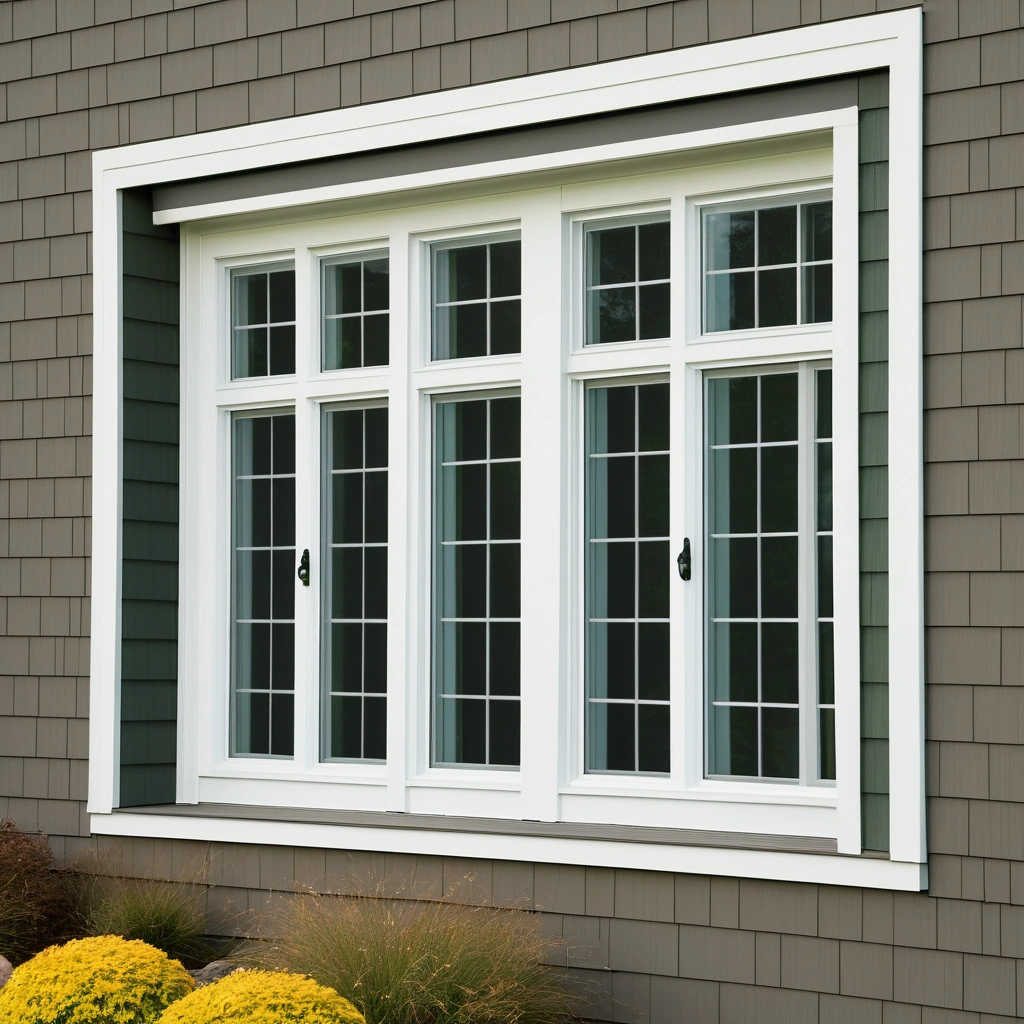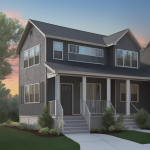Maximizing Energy Savings: A Homeowner’s Guide to Selecting Energy-Efficient Window and Siding Combinations
Introduction: The Power of Window and Siding Synergy
In an era defined by escalating energy costs and a heightened awareness of environmental stewardship, homeowners are actively pursuing strategies to minimize their carbon footprint and curtail utility expenditures. While considerable attention is often directed toward insulation upgrades and advanced HVAC systems, the synergistic relationship between windows and siding, frequently underestimated, exerts a profound influence on a home’s overall energy performance. Selecting the appropriate window and siding combinations represents a pivotal decision, directly impacting a home’s capacity to maintain thermal equilibrium, retaining warmth during colder months and ensuring a cool interior throughout the summer season.
This comprehensive guide empowers homeowners with the requisite knowledge to navigate the complexities of energy-efficient home improvement, enabling informed choices concerning energy-efficient windows and energy-efficient siding, ultimately fostering long-term home energy savings and cultivating a more comfortable and sustainable living environment. The selection of optimal window and siding combinations extends beyond mere aesthetics, representing a strategic investment in long-term energy efficiency and cost reduction. A well-considered pairing acts as a cohesive thermal barrier, mitigating heat transfer and minimizing reliance on energy-intensive heating and cooling systems.
For instance, integrating energy-efficient windows boasting low U-factors with insulated vinyl siding featuring a high R-value creates a formidable defense against temperature fluctuations. By effectively minimizing thermal bridging and air infiltration, these window and siding combinations contribute significantly to reducing energy consumption and enhancing overall home comfort. Understanding the interplay between these components is crucial for maximizing home energy savings. Furthermore, homeowners should consider the long-term return on investment (ROI) associated with upgrading to energy-efficient windows and siding.
While the initial investment may seem substantial, the cumulative savings on energy bills over the lifespan of the products can be significant. Government incentives, tax credits, and utility rebates may also be available to offset the upfront costs, further enhancing the financial attractiveness of these home improvement projects. Beyond the direct financial benefits, upgrading to energy-efficient windows and siding enhances the overall value and marketability of the property, making it a worthwhile investment for homeowners seeking to improve their living spaces and reduce their environmental impact. Properly installed energy-efficient windows and siding contribute to a more comfortable, sustainable, and valuable home.
The Interplay: Windows, Siding, and Home Energy Performance
Windows and siding function as an integrated thermal envelope, a critical defense against the vagaries of the external environment. Inefficient windows represent a significant vulnerability, acting as conduits for heat loss during colder months and allowing excessive solar heat gain during warmer periods. Simultaneously, siding serves as the initial barrier against temperature fluctuations, precipitation, and potential moisture intrusion. Optimizing the selection and installation of both components creates a synergistic effect, minimizing energy waste and bolstering overall home comfort.
The interplay between these elements directly impacts a home’s energy footprint, influencing heating and cooling demands throughout the year. A mismatch between window and siding performance can undermine even the most advanced HVAC systems. For instance, installing high-efficiency HVAC alongside single-pane windows and poorly insulated siding is akin to pouring water into a leaky bucket. Conversely, strategic window and siding combinations, leveraging advancements in materials science and building technology, can substantially reduce the burden on heating and cooling equipment, yielding tangible home energy savings.
Selecting energy-efficient windows with low U-factors and appropriate SHGC values, paired with energy-efficient siding boasting a high R-value, forms the bedrock of a high-performance thermal envelope. Understanding the principles of thermal bridging is also crucial in maximizing the effectiveness of window and siding combinations. Thermal bridges are pathways through which heat can easily flow, bypassing the intended insulation. Window frames, siding attachment points, and gaps in insulation can all act as thermal bridges, diminishing the overall energy efficiency of the building envelope. Employing proper installation techniques, such as using thermal breaks and ensuring airtight seals, mitigates thermal bridging, further enhancing home improvement efforts and maximizing energy savings. Insulated siding options, like those incorporating a foam backing, can significantly reduce thermal bridging compared to traditional siding materials. Therefore, careful consideration of these factors is paramount when selecting window and siding combinations for optimal energy performance.
Window Selection: Key Factors for Energy Efficiency
Selecting energy-efficient windows involves understanding several key performance metrics that directly impact home energy savings. The U-factor, a critical measurement, quantifies the rate of heat transfer through a window assembly; lower U-factors signify superior insulation capabilities, reducing heat loss in winter and heat gain in summer. For instance, replacing old single-pane windows with Energy Star certified windows boasting a U-factor of 0.30 or lower can dramatically decrease heating bills. Solar Heat Gain Coefficient (SHGC) measures the fraction of solar radiation admitted through a window.
Lower SHGC values are particularly desirable in hot climates to minimize solar heat gain, thus reducing the load on air conditioning systems. Conversely, in colder climates, a slightly higher SHGC might be acceptable to harness passive solar heating, but careful consideration of window orientation is crucial to avoid overheating during peak sun hours. Air leakage ratings, measured in cubic feet per minute per square foot (cfm/sq ft), indicate the extent of air infiltration through the window unit; stringent standards demand lower ratings, signifying tighter seals and reduced drafts, contributing significantly to overall energy efficiency.
Frame materials play a pivotal role in the overall thermal performance of energy-efficient windows. Vinyl and fiberglass frames generally outperform aluminum frames due to their inherently lower thermal conductivity. Aluminum, while strong and durable, is a highly conductive material, leading to increased heat transfer. Many modern aluminum frames incorporate thermal breaks – sections of less conductive material – to mitigate this effect, but vinyl and fiberglass remain superior choices for insulation. Wood frames offer good insulation but require more maintenance to prevent rot and warping.
The choice of frame material often involves balancing energy efficiency with aesthetic preferences and budget considerations. For example, a homeowner might choose fiberglass frames for their durability and paintability, accepting a slightly higher upfront cost for long-term performance and reduced maintenance. Glazing options are another crucial aspect of energy-efficient window selection. Double-pane and triple-pane windows, often filled with inert gases like argon or krypton, significantly enhance insulation. Low-emissivity (Low-E) coatings applied to the glass further reduce heat transfer by reflecting infrared radiation.
A double-pane window with a Low-E coating and argon fill can achieve a U-factor nearly half that of a standard double-pane window without these features. The specific type of Low-E coating should be chosen based on climate; some are designed to maximize solar heat gain in winter, while others are optimized to minimize it in summer. Furthermore, consider the impact of window design and installation; even the most energy-efficient windows will underperform if not properly installed and sealed, potentially leading to thermal bridging and air leaks that negate their energy-saving benefits. Professional installation is a key investment in realizing the full potential of your window and siding combinations for home energy savings.
Siding Selection: Key Factors for Energy Efficiency
Siding also plays a vital role in energy efficiency, acting as a crucial component of your home’s thermal envelope. The R-value, a measure of a material’s resistance to heat flow, is a primary consideration; higher R-values indicate better insulation and reduced energy loss. Material types such as vinyl, fiber cement, wood, and metal offer varying levels of insulation, impacting overall home energy savings. Insulated vinyl siding, for instance, incorporates a layer of foam insulation that significantly increases its R-value, providing enhanced thermal performance compared to traditional, uninsulated options.
Choosing the right siding material directly contributes to minimizing heat transfer and maintaining a consistent indoor temperature, thereby reducing reliance on heating and cooling systems. This is especially impactful when combined with energy-efficient windows. Insulation options like rigid foam boards or spray foam can be added behind the siding to further improve thermal performance and contribute significantly to home improvement efforts. These additional layers of insulation create a more robust barrier against temperature fluctuations. However, it’s crucial to consider the impact on thermal bridging, where heat can transfer through studs and other structural elements, bypassing the insulation.
Proper insulation techniques, like using thermal breaks—materials with low thermal conductivity placed between the siding and the studs—can minimize thermal bridging and maximize the effectiveness of the insulation. Selecting energy-efficient siding and addressing thermal bridging are essential for creating a truly energy-efficient home. For example, fiber cement siding, known for its durability and aesthetic appeal, can be paired with a layer of continuous insulation to significantly reduce heat loss compared to traditional wood siding with no insulation. This combination not only enhances the home’s energy efficiency but also contributes to its overall structural integrity and resistance to the elements. Moreover, the choice of siding color can also play a role; lighter colors reflect more sunlight, reducing heat absorption in warmer climates, while darker colors absorb more heat, which could be beneficial in colder climates. Selecting appropriate window and siding combinations, alongside proper installation, is key to maximizing long-term home energy savings.
Climate-Specific Combinations: Maximizing Energy Savings
The optimal window and siding combination depends heavily on your climate zone, making a tailored approach essential for maximizing home energy savings. In cold climates, the priority is retaining heat. Therefore, prioritize energy-efficient windows with low U-factors (indicating superior insulation) and potentially higher SHGC values to capture solar heat gain during the day. Siding with high R-values, signifying greater resistance to heat flow, and minimal thermal bridging is also essential to prevent heat loss through the walls.
Consider vinyl siding with added insulation, offering a cost-effective solution, or fiber cement siding with continuous insulation for enhanced thermal performance. Proper sealing around window and siding joints is also critical to eliminate drafts and maintain a consistent indoor temperature. In hot climates, the goal shifts to minimizing heat gain. Focus on energy-efficient windows with low SHGC values to block solar radiation and low U-factors to prevent heat transfer from the outside. Siding should be light-colored to reflect sunlight and reduce heat absorption, and it should also possess good insulation properties.
Reflective coatings on windows and radiant barriers behind the siding can further enhance energy efficiency. Consider options like light-colored fiber cement siding, known for its durability and ability to reflect sunlight, or engineered wood siding with a reflective finish. Remember that adequate ventilation in attics and wall cavities is also crucial to dissipate any accumulated heat. In mixed climates, where both heating and cooling are significant concerns, a balanced approach is necessary when selecting window and siding combinations.
Windows with moderate U-factors and SHGC values provide a versatile solution, allowing for some solar heat gain in the winter while limiting excessive heat gain in the summer. Similarly, well-insulated siding with a mid-range R-value offers a compromise between heat retention and heat reflection. For example, in a cold climate, consider fiberglass windows with triple-pane glazing, argon fill, and low-E coating paired with insulated vinyl siding (R-value of 3-5). In a hot climate, opt for vinyl windows with double-pane glazing, low-E coating (specifically designed for warm climates), and argon fill, combined with light-colored fiber cement siding and a radiant barrier. Understanding your local climate and its specific heating and cooling demands is paramount to making informed decisions about window and siding combinations for optimal home energy savings.
Installation and ROI: The Long-Term Benefits
Even the most energy-efficient windows and siding will perform poorly if not installed correctly. Professional installation ensures proper sealing, insulation, and flashing, preventing air and water leaks that can compromise home energy savings. Improper installation can lead to drafts, moisture damage, and reduced energy efficiency, negating the benefits of the upgraded materials and potentially leading to costly repairs down the line. Investing in professional installation is crucial for maximizing the long-term performance and cost savings of your window and siding upgrades, ensuring that the U-factor, SHGC, and R-value ratings translate into tangible benefits for your home.
The initial cost of professional installation is often offset by the long-term energy savings and reduced maintenance costs associated with properly installed energy-efficient windows and energy-efficient siding. Furthermore, reputable installers typically offer warranties that protect your investment against defects in workmanship, providing an added layer of security and peace of mind. These warranties can cover issues such as air and water infiltration, ensuring that your home remains comfortable and energy-efficient for years to come. Choosing experienced professionals for your home improvement project is an investment in the longevity and performance of your window and siding combination.
Over time, energy-efficient windows and siding will lead to significant cost savings on your utility bills, contributing to a substantial return on investment. The exact ROI depends on factors such as your climate, energy usage habits, the specific products chosen (considering U-factor, SHGC, and R-value), and the quality of the installation. For example, in colder climates, opting for windows with low U-factors and siding with high R-values can dramatically reduce heat loss, while in warmer climates, windows with low SHGC values and siding that minimizes thermal bridging can keep your home cooler.
However, homeowners can typically expect to recoup their investment within a reasonable timeframe, while also enjoying a more comfortable and energy-efficient home. Beyond the direct financial benefits, properly installed energy-efficient windows and siding contribute to a healthier and more comfortable living environment. By minimizing drafts and moisture intrusion, these upgrades can reduce the risk of mold growth and improve indoor air quality. Moreover, the enhanced insulation provided by energy-efficient window and siding combinations can create a more consistent and comfortable temperature throughout your home, eliminating hot and cold spots. This holistic approach to home improvement not only saves money but also enhances the overall quality of life for you and your family.


